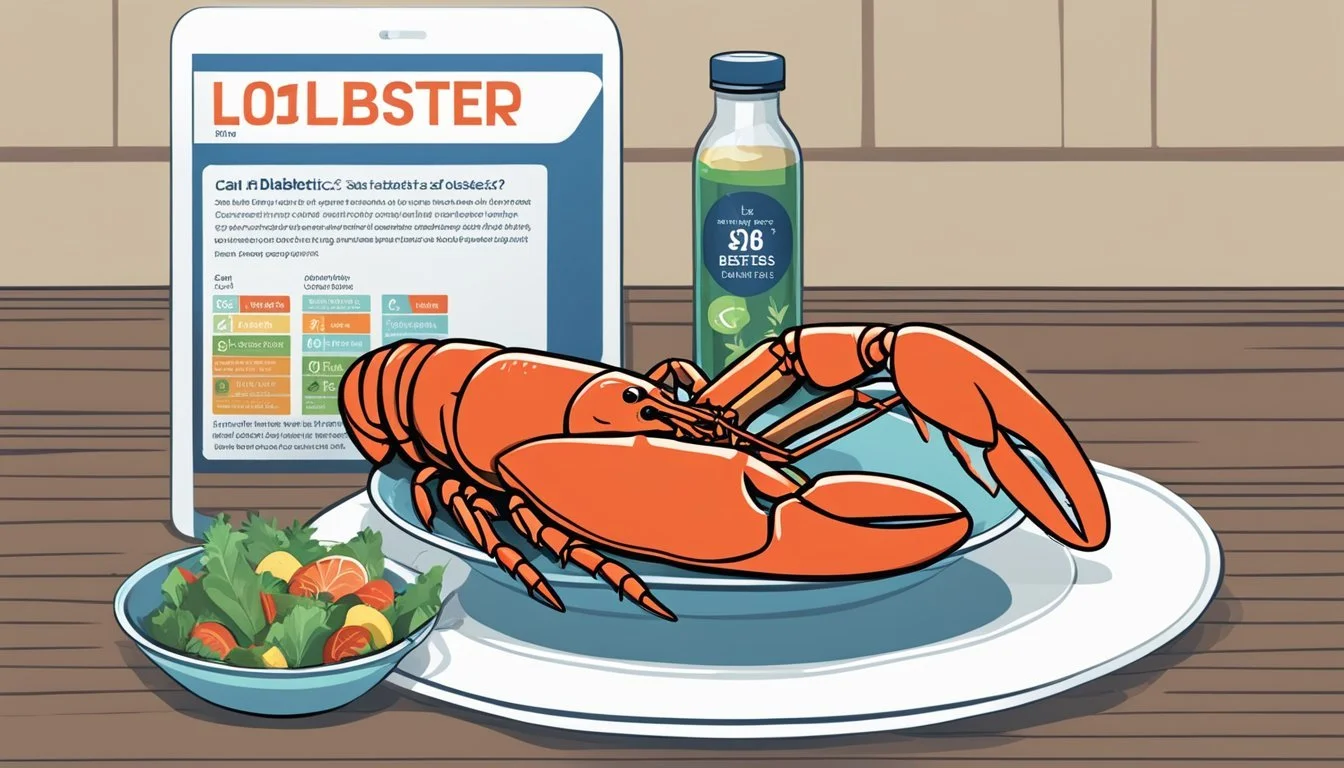Can Diabetics Eat Lobster?
A Nutritional Guide
Lobster is a seafood delicacy enjoyed by many, but can diabetics include it in their diet? Yes, diabetics can safely eat lobster. Lobster is a low-carb, high-protein food that fits well into a diabetic meal plan. It also offers essential nutrients like omega-3 fatty acids, which are beneficial for heart health.
In addition to being low in carbs, lobster provides lean protein which helps maintain stable blood sugar levels. This makes it a satisfying option that can keep you full without causing significant spikes in glucose. While it does contain cholesterol, the overall fat content is relatively low, making it a balanced choice for those managing diabetes.
Given its nutritional profile, incorporating lobster into meals can be both a tasty and health-conscious decision for diabetics. It’s important, however, to prepare it in a healthy manner, avoiding high-fat cooking methods like deep-frying, to maximize its benefits.
Understanding Diabetes and Dietary Concerns
For individuals with type 2 diabetes, dietary choices are crucial in managing blood sugar levels and overall health. The focus is often on balancing carbohydrates, proteins, and fats to maintain optimal glucose levels.
Impact of Diet on Blood Sugar Levels
Diet significantly influences blood sugar levels. Consuming high-carb foods can cause rapid spikes in glucose, particularly for those with insulin resistance. The American Diabetes Association recommends a balanced diet emphasizing vegetables, whole grains, lean protein, and healthy fats.
Carbohydrates play a vital role but should be monitored. Low-carb diets often help in controlling diabetes, as they minimize blood sugar surges. Including complex carbohydrates with a low glycemic index can support steady glucose release.
Healthy fats, such as those found in avocados and nuts, can improve insulin sensitivity. On the other hand, high intake of saturated fat should be avoided, as it can exacerbate insulin resistance and impact heart health.
The Role of Protein in Diabetes Management
Protein is essential for managing diabetes. Lean proteins help maintain muscle mass and keep blood sugar levels stable. Lobster, for instance, is high in protein and low in carbs, making it an excellent choice for diabetics.
Including adequate amounts of protein in meals can reduce hunger and prevent overeating, crucial for those with type 2 diabetes. A diet rich in proteins can also aid in weight management, which is vital for controlling diabetes.
Proteins from both plant and animal sources, like beans, lentils, fish, and lean meats, should be included. These proteins contribute to a balanced diet and help manage the body's insulin response effectively.
Nutritional Profile of Lobster
Lobster offers a highly nutritious profile favorable for diabetics due to its low carbohydrate content and beneficial vitamins and minerals. Let's explore its macronutrients and essential vitamins and minerals in detail.
Lobster's Macronutrient Content
Lobster is exceptionally low in carbohydrates, making it suitable for individuals managing blood glucose levels. A 100-gram serving of cooked lobster contains:
Calories: Approximately 90
Protein: An impressive 19 grams
Fat: Less than 1 gram
Saturated Fat: Minimal
Cholesterol: 72 milligrams
The high protein content helps stabilize blood sugar and provide sustained energy. With a mere trace of fat and zero carbs, lobster is a low-calorie option that supports dietary goals without compromising flavor or nutritional value.
Vitamins and Minerals in Lobster
Lobster is a rich source of essential vitamins and minerals, enhancing its nutritional appeal. Key nutrients include:
Vitamin B12: Promotes healthy nerve function and the production of red blood cells.
Selenium: Supports antioxidant protection and thyroid function.
Zinc: Essential for immune health and wound healing.
Copper: Important for cardiovascular health.
Iodine: Crucial for thyroid health.
Omega-3 Fatty Acids: Small but beneficial amounts contribute to heart and brain health.
Lobster also contains other minerals like iron, magnesium, and phosphorus, which support various bodily functions. High levels of vitamin B12 and selenium particularly stand out for their significant health benefits.
Comparative Health Benefits of Seafood
Seafood offers numerous health benefits, particularly for individuals managing diabetes. Different varieties provide unique advantages, making them essential for maintaining a balanced and heart-healthy diet.
Benefits of Fish and Shellfish Varieties
Fish such as salmon, trout, and mackerel are rich in omega-3 fatty acids, which are known for their anti-inflammatory properties. Omega-3s support blood sugar regulation and improve insulin sensitivity, making them beneficial for diabetics.
Shellfish like shrimp and scallops are low in calories and high in protein. This high protein content helps control blood sugar levels and promotes satiety, reducing the risk of overeating.
Seafood and Heart Health
The American Heart Association recommends consuming fatty fish like sardines, tuna, and salmon to support heart health. These fish are especially rich in omega-3 fatty acids, which reduce the risk of heart disease by lowering triglyceride levels and blood pressure.
Regular consumption of these seafood varieties can lessen inflammation and improve cholesterol profiles, crucial for preventing heart disease. Ensuring a diet rich in omega-3 fatty acids from seafood can significantly impact overall cardiac health, providing essential nutrients for maintaining a healthy heart.
Incorporating Lobster in a Diabetes-Friendly Diet
When adding lobster to a diabetes-friendly diet, consider both the preparation methods and portion sizes. Emphasize low-fat, high-protein benefits while avoiding unhealthy additives.
Preparing Lobster Without Compromising Nutrition
Use healthy cooking methods like boiling, steaming, baking, or grilling to retain nutritional value. Avoid high-carbohydrate or high-fat additions by keeping recipes simple.
Healthy Cooking Methods:
Steaming: Steaming lobster ensures it retains its nutrients and flavor. Add olive oil, lemon, and fresh herbs for extra taste.
Grilling/Broiling: These methods add a smoky flavor without extra fats. Use minimal oil and seasoning.
Boiling: This method is quick and helps preserve the lobster’s high-protein content.
Avoid rich sauces or breaded preparations to keep it low-carb and diabetes-friendly.
Appropriate Portion Sizes and Frequency
Control portion sizes to avoid blood sugar spikes. A typical serving size might be around 3-4 ounces, aligning with recommended protein intake.
Portion Sizes:
3-4 ounces of lobster per serving to manage carbs and calories.
Include plenty of vegetables to balance the meal.
Frequency:
Incorporate lobster into your diet once or twice a week. This frequency ensures variety while taking advantage of lobster’s nutritional benefits.
By focusing on these key aspects, individuals with diabetes can enjoy lobster without compromising their dietary needs.
Healthy Meal Pairings With Lobster
Pairing lobster with the right sides and seasonings can enhance its nutritional benefits, especially for diabetics. Focus on low-carb vegetables, whole grains, and healthy sauces to create balanced and delicious meals.
Vegetable and Grain Side Options
Non-starchy vegetables:
Broccoli
Green beans
Asparagus
These vegetables are low in carbs and provide essential nutrients.
Salads:
Spinach or kale base
Add toppings like tomatoes, cucumbers, and bell peppers
Fat-free or low-fat dressings keep the carb count low and provide a nutritious balance.
Whole grains:
Quinoa
Barley
Brown rice
Each option supports blood sugar control by adding fiber and important vitamins.
Beans and legumes:
Lentils
Chickpeas
They are excellent sources of protein and fiber, which help in managing blood glucose levels.
Ideal Sauces and Seasonings for Diabetics
Healthy fats:
Olive oil
Avocado oil
These oils provide flavor without adding unhealthy fats.
Low-calorie options:
White wine
Lemon juice
Both enhance flavor without adding extra sugar or carbs.
Garlic and fresh herbs:
Basil
Parsley
Thyme
These seasonings add robust flavor without increasing the glycemic load.
Certified diabetes care and education specialists recommend simple, low-sugar sauces like:
Yogurt-based tzatziki
Homemade tomato salsa
Both options are delicious and contain little to no added sugar.
Spices:
Paprika
Black pepper
Simple spices can elevate the taste without causing blood sugar spikes. Consider consulting a dietitian for personalized advice.
Potential Risks and Precautions
Lobster can be a nutritious addition to a diabetic diet, but there are some risks to monitor. These include managing sodium and cholesterol intake, as well as being cautious about mercury and other contaminants.
Managing Sodium and Cholesterol Levels
While lobster is low in fat, it can be high in sodium and cholesterol. Sodium can influence blood pressure, a key concern for diabetics. A 3-ounce serving of cooked lobster contains approximately 370 milligrams of sodium. Reducing added salt and choosing fresh lobster over processed products can help manage sodium levels.
Cholesterol is another consideration. Lobster has moderate cholesterol levels, with about 124 milligrams per 3-ounce serving. Since cholesterol affects heart health, it’s wise for diabetics to monitor their intake. Combining lobster with heart-healthy foods like vegetables can offset risks.
Considerations for Mercury and Other Contaminants
Seafood, including lobster, may contain mercury and other contaminants. The FDA advises diabetics and others to consume seafood in moderation. High mercury levels can negatively impact the nervous system and kidney function, posing a greater risk for those with existing health issues.
Additionally, sustainably sourced lobster tends to have fewer contaminants. Verifying the source and choosing wild-caught options over farmed can reduce the risk of exposure. With these precautions, lobster can be a safe part of a diabetic diet.
Expert Dietary Advice and Personalized Planning
When considering whether diabetics can eat lobster, it is essential to consult health professionals and create a balanced meal plan. These strategies help manage diabetes effectively while allowing for an occasional treat like lobster.
Consulting With Health Professionals
Consulting with a healthcare provider is crucial for managing diabetes. A certified diabetes care and education specialist can offer tailored advice. They assess vitals such as blood sugar levels and insulin resistance, ensuring dietary changes are safe and effective.
A dietitian can help design a meal plan that fits individual needs. They provide guidance on portion sizes and meal frequency. Regular check-ins help adjust the plan based on progress and health changes. Professional advice ensures that eating lobster does not compromise health.
Creating a Balanced Diabetes Meal Plan
A balanced diabetes meal plan includes the right mix of proteins, fats, and carbohydrates. Adding lobster, which is high in protein and low in fat, can complement this balance. Lobster should be prepared healthily, avoiding high-fat cooking methods.
Maintaining a low glycemic impact is vital. Including non-starchy vegetables and whole grains helps manage blood sugar levels. Portion control is critical, especially with foods higher in calories. Regularly monitoring blood glucose levels can help adjust the plan as needed.
By creating a personalized and balanced meal plan, diabetics can enjoy lobster while managing their condition effectively.






